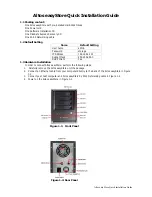
UMN:CLI
User Manual
V8102
432
The delegating router acts as a DHCP server, and is responding to the prefix request. It is
configured with a set of prefixes to be used for assignment to customers at the time of
each customer's first connection to the ISP service. The prefix delegation process begins
when the requesting router requests configuration information through DHCPv6. The
DHCP messages from the requesting router (DHCP client) are received by the delegating
router in the aggregation device. When the delegating router receives the request, it se-
lects an available prefix or prefixes for delegation to the requesting router. The delegating
router then returns the prefix or prefixes to the requesting router. The requesting router
subnets the delegated prefix and assigns the longer prefixes to links in the subscriber's
network. The requesting router subnets a single delegated /48 prefix into /64 prefixes and
assigns one /64 prefix to each of the links in the subscriber network.
The prefix delegation options can be used in conjunction with other DHCP options carry-
ing other configuration information to the requesting router. The requesting router pro-
vides DHCP service to hosts attached to the internal network. For example, the request-
ing router may obtain the addresses of DNS and NTP servers from the ISP delegating
router, and then pass that configuration information on to the subscriber hosts through a
DHCP server in the requesting router.
DHCPv6 Basic Operation
DHCPv6 clients and servers exchange DHCP messages using UDP port. DHCPv6 clients
listen for DHCP messages on UDP port 546. DHCPv6 servers and relay agents listen for
DHCPv6 messages on UDP port 547. The client can obtain server or relay agent
’s ad-
dress using All-DHCP-Server and All-DHCP-Agent address.
Port
Port #
Description
Client
UDP
546
Clients listen for DHCP messages on UDP port 546.
Server
UDP
547
Server and relay agents listen for DHCP messages on UDP
port 547.
Tab. 9.5
DHCPv6 UDP port
There are no broadcast addresses defined for IPv6. Therefore, the use of the limited
broadcast address for some DHCPv4 messages has been replaced with the use of the
site-scoped multicast address (FF05::1:3) and link-scoped multicast address (FF02::1:2)
for DHCPv6.
DHCPv6 Multicast Address
Description
All_DHCP_Servers
(Site-local scope)
FF05::1:3
A site-scoped multicast address used by a relay agent or client
to communicate with servers, either because the relay agent
wants to send messages to all servers or because it does not
know the unicast addresses of the servers. All DHCP servers
within a site are members of this multicast group.
All_DHCP_Relay_Agents
_and_Servers
(Link-local scope)
FF02::1:2
A link-scoped multicast address used by a client to communi-
cate with neighboring (i.e., on-link) relay agents and servers.
All servers and relay agents are members of this multicast
group.
Tab. 9.6
DHCPv6 Address
















































